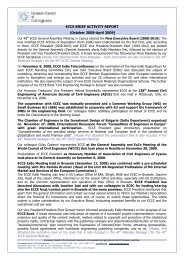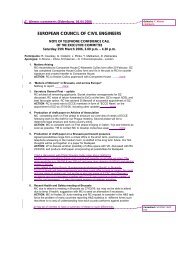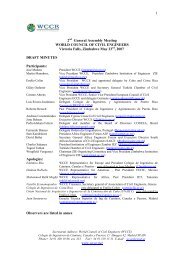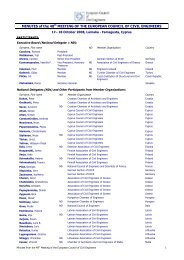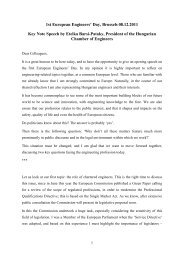A Closer Look at Prevailing Civil Engineering Practice - European ...
A Closer Look at Prevailing Civil Engineering Practice - European ...
A Closer Look at Prevailing Civil Engineering Practice - European ...
You also want an ePaper? Increase the reach of your titles
YUMPU automatically turns print PDFs into web optimized ePapers that Google loves.
A <strong>Closer</strong> <strong>Look</strong> <strong>at</strong> <strong>Prevailing</strong> <strong>Civil</strong> <strong>Engineering</strong> <strong>Practice</strong>, Wh<strong>at</strong>, Why and How<br />
Vincent T. H. CHU<br />
Release agent:<br />
Form oils:<br />
M<strong>at</strong>erials th<strong>at</strong> contain ingredients which are<br />
chemically combined with cement.<br />
Diesel oils or other oil types.<br />
Form releaser<br />
and demoulding agent: General terms to describe m<strong>at</strong>erials which perform<br />
separ<strong>at</strong>ion of forms from concrete.<br />
6. How can release agent help to separ<strong>at</strong>e formwork from concrete<br />
There are generally two main types of form releaser: barrier type or<br />
chemically active type.<br />
For barrier type (e.g. form oil), it cre<strong>at</strong>es a barrier between the form and the<br />
fresh concrete. However, the quick evapor<strong>at</strong>ion of diesel oils affects clean<br />
air.<br />
For chemically active type (e.g. release agent), an active ingredient (e.g.<br />
f<strong>at</strong>ty acid) chemically combines with calcium (lime) in the fresh cement<br />
paste. This calcium/f<strong>at</strong>ty acid product (grease or metallic soap) is stable<br />
and causes the formwork to release from the hardened concrete. It is this<br />
slippery, greasy, non-w<strong>at</strong>er soluble soap which allows the easy releasing<br />
of formwork from hardened concrete.<br />
7. Wh<strong>at</strong> are the potential problems of excessive applic<strong>at</strong>ion of form<br />
oils<br />
The problems of excessive applic<strong>at</strong>ion of form oils are:<br />
(i) It stains the surface of hardened concrete.<br />
(ii) Excess oils have nowhere to escape and find its way inside the<br />
cement paste and form holes subsequently. The oils bead up<br />
because of its incomp<strong>at</strong>ibility with w<strong>at</strong>er in chemical n<strong>at</strong>ure.<br />
(iii) Higher cost is associ<strong>at</strong>ed with increased usage of form oils.<br />
(iv) In a rel<strong>at</strong>ively short time essentially most diesel oil evapor<strong>at</strong>es so<br />
th<strong>at</strong> it cre<strong>at</strong>es environmental problem.<br />
8. Curing time in summer is less than th<strong>at</strong> in winter. Why<br />
While concrete sets, it gains hardness and strength as the process of<br />
hydr<strong>at</strong>ion slowly spreads the entire body of m<strong>at</strong>erial. Curing should be<br />
16








